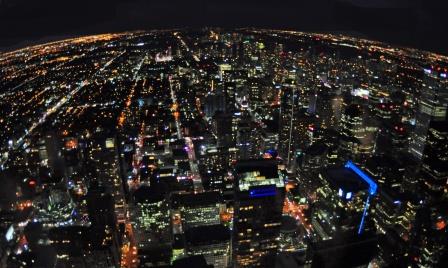How swarm technology spurs the energy revolution

SmartLight systems in Saxony-Anhalt provide energy-efficient lighting technology on country roads
In many municipalities, street lights illuminate also rarely used roads for the whole night. This is a waste of energy and causes unnecessary stress for animals. Young researching entrepreneurs of Anhalt University of Applied Sciences are working on street lights communicating with one another which illuminate the road only if people are present.
From the perspective of astronauts on board the International Space Station ISS, many regions of the earth look like a lit-up Christmas tree at night. Cities and towns are marked by countless light points. Illuminated motorways, streets, cycle tracks and paths form a thick network of lights between them. “There are around nine million electric street lamps in Germany alone, and over 350 million worldwide”, Prof. Dr. Eduard Siemens of the specialist field of Electrical Engineering, Mechanical Engineering and Business Engineering at Anhalt University of Applied Sciences in Köthen explains. Even if power-saving LED street lights are used more and more, it is a waste of energy if they illuminate barely used streets and roads for the entire night. Furthermore, many nocturnal animal species are stressed out by the bright and constantly luminous lamplights. Biologists could demonstrate that so-called “light pollution” contributes to current insect deaths and to behavioural changes in songbirds.
Smart solutions for street lighting
“Around a decade ago I had some initial ideas on how to achieve intelligent technical solutions for street lighting”, Prof. Siemens states. This led to several patent applications. However, the practical implementation came after transferring to Anhalt University of Applied Sciences as the Head of Future Internet Lab Anhalt (FILA). Together with PhD students and in cooperation with Prof. Dr. Ingo Chmielewski, Head of Embedded Systems Lab at Anhalt University of Applied Sciences and with the support of the city and public utilities of Bernburg, the researchers built an approx. one kilometre-long test track over a year ago and founded the start-up company SmartLight. Its aim is to produce the technology preferably in Saxony-Anhalt in the future and to market it at both a national and international level.
19 street lights communicate with one another
On the test track - a pedestrian and cycle path between the outskirts of Bernburg and the Bernburg-Strenzfeld university campus - 19 LED street lights communicate with one another. If nobody is around, the path stays dark. If somebody approaches the lights, these are gradually switched on.
In theory, this sounds simple. But the devil is notoriously in the practical details. Ultimately, the lighting system must switch on and off reliably at any time. Erroneous activations by dogs, stray cats and wild animals must be avoided. Furthermore, the intelligent lighting system must detect at which speed road users move, so that the right area of the road is always illuminated in advance.
97.5 percent of energy saving by SmartLight in Bernburg
The technical hurdles for the practical implementation have been so great that, in contrast to SmartHome solutions for lighting and heating control at home, there have been no commercial suppliers with a reliable SmartLight system for public roads on the market so far.
“We also had initial difficulties on our test track”, Professor Siemens says. Light control has now been improved with modern swarm technologies, and the luminosity of the light has now been dimmed to three percent when the road is not used. “In the course of a year, we reached energy saving of 97.5 percent”, the university researcher and start-up founder reports. The passive infra-red sensors used as light triggers should soon be replaced by image sensor technology. They should continue to improve the reliability and error rate of the system. It is not planned to use video cameras with which people or licence plates can be identified. “We do not intend to use our system to monitor people”, the scientist adds.
SmartLight for streets as an integral part of a Smart City
The work on an intelligent street lighting system from Saxony-Anhalt has also attracted great interest abroad. There have been many inquiries, including from Kazakhstan, Qatar, Russia and Ukraine. India made the offer of using intelligent street lighting in a “Smart City” on the subcontinent and of developing it further there.
The young researching entrepreneurs in Saxony-Anhalt are also interested in the development of ecological test tracks - most importantly in Germany, on public streets or, for instance, on large-scale industrial complexes and in business parks. “I think that intelligent street lighting will soon take hold globally”, Prof. Siemens, the researcher from Saxony-Anhalt, predicts.
Author: Uwe Seidenfaden
